Patton tanks and its variants were the main armor used throughout the war in Vietnam. The variants included the M48A3, M48A2C, M48/M60 AVLB, M67A2 Flame tank, M88 ARV, and the M728 CEV.

M48A3 Patton (Late Model) Specifications
- Crew: 4
- One 90mm Gun M41 on M87A1 mount in turret, 62 rounds
- One .50 Caliber MG HB M2 in cupola on turret, 600 rounds
- One 7.62mm MG M73 coaxial with 90mm gun, 5900 rounds
- Xenon AN/VSS-1 2.2 kilowatt white light/infrared searchlight
or a Crouse-Hinds 18 inch diameter searchlight without infared - Tracks: T97E2, Double pin, 28 inch width, rubber chevron
Pitch: 6.94 inches, Shoes per tank: 158 (79 / track) - Maximum Armor: 4.33 inches (110mm), Front upper hull (60 degrees)
- Engine: Continental AVDS-1790-2A. 12 cylinder, 4 cycle,
- Fuel: 385 gallons (1457 Liters) 40 octane diesel
- Cruising Range on roads: approximately 300 miles (483 km)
- Maximum Speed (level road): 30 mph (48.3 km/hr)

90mm basic load:
Half and half mixture of high explosive (HE) and canister rounds along with several specialty rounds: two rounds of high explosive anti-tank (HEAT), several rounds of white phosphorous (WP or “Willie Peter”) and a few high explosive concrete-piercing (HECP). The 90mm gun was boresighted to 800 meters (875 yards).
The 90mm M336 canister anti-personnel round was a projectile filled with 1,280 spherical steel pellets for anti-personnel use at short ranges. It was similar in action as to a gigantic shotgun shell which spread a swathe of metal shards to a distance of 250 meters (273 yards). It was highly effective in stripping vegetation concealing enemy positions and against obstacles such as barbed wire entanglements or even to detonate mines in the path of the tank. The extensive use of canister rounds led to the cracking of the blast defectors on the M48A3s after firing 100+ rounds. A rate far beyond the design parameters of the 90mm gun. The 90mm M377 “Beehive” round superseded the M336 which contained 5600 flechettes (darts) and had a variable time fuse with settings for detonation from point blank range to 4000 meters (2.5 miles).

US armor units that served in Vietnam
Tank Battalions:
- 1st Marine Tank Battalion, 1st Marine Division
- 3rd Marine Tank Battalion, 3rd Marine Division
- 2nd Battalion, 34th Armor Regiment, 4th Infantry Division
- 1st Battalion, 69th Armor Regiment, 25th Infantry Division (later the 4th)
- 1st Battalion, 77th Armor Regiment, 5th Infantry Division (Mechanized)
Armored Cavalry Squadrons:
- 1st Squadron, 1st Cavalry, 23rd Infantry Division
- 2nd Squadron, 1st Cavalry, 4th Infantry Division
- 1st Squadron, 4th Cavalry, 1st Infantry Division
- 3rd Squadron, 4th Cavalry, 25th Infantry Division
- 3rd Squadron, 5th Cavalry, 9th Infantry Division
- 1st Squadron, 10th Cavalry, 4th Infantry Division
- 1st Squadron, 11th Armored Cavalry Regiment
- 2nd Squadron, 11th Armored Cavalry Regiment
- 3rd Squadron, 11th Armored Cavalry Regiment
- 4th Squadron, 12th Cavalry, 5th Infantry Division (Mechanized)
- 2nd Squadron, 17th Cavalry, 101st Airborne Division
The first M48A3 tanks deployed to South Vietnam did not belong to the US Army but to the US Marine Corps. On 8 March 1965, 3rd Platoon tanks from Bravo Company, 3rd Marine Tank Battalion landed in South Vietnam and by 8 July 1965 the remainder of the battalion had join them. These M48A3s in a Landing Craft Utility (LCU) are heading for the shores of South Vietnam.

Due to a lack of port facilities in Vietnam, the US Marines executed a traditional amphibious landing similar to 15 years earlier at Inchon, Korea. LCU-1476 departed the well deck of Amphibious Transport Dock USS Vancouver (LPD-2) and crossed the Bay of Da Nang on their way to Red Beach during the first major US amphibious landing in South Vietnam.

M48A3s equipped with deep fording kits wade ashore from the beached LCU.
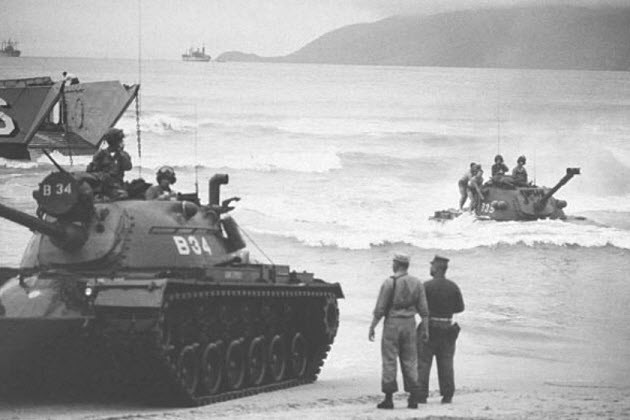
Tank B33 was launched into water above the fording depth of the tank and struggles to come ashore through the surf. Note that the water is covering the driver’s hatch.

This M48A3 with a deep water fording exhaust stack attached on the rear coming off a landing craft on 7 September 1965. Note the support cable attached to the exhaust stack.

Film: Da Nang 1965
Operation Starlite, 18 to 24 August 1965
The tank units were HQS, Charlie Company, 3rd Tank Battalion and 3rd Platoon, Alpha Company, 3rd Tank Battalion. After wading ashore, the tanks were soon involved a fierce firefight and three of tanks (A-31, A-32 and A-35) were knocked out by 75mm recoilless rifle fire. This was the first occasion which this weapon had been encountered firing anti-tank ammunition. In this photo, a marine crouches by the bodies of the Viet Cong (VC) anti-tank team that knocked out tank A-32 in the background.

This M48A3 of the 3rd Marine Tank Battalion, seen near Dong Ha on 2 March 1967, is equipped with the early 18-inch Crouse-Hinds searchlight (no intrared). Note the driver’s periscopes are in the raised position in this photo.

Film: MARINE CORPS TANKERS IN THE VIETNAM WAR
Film: Republic of Vietnam with US 1st Marine Division, 1st Tank Battalion. 1967-68.
This M48A3 belonged to Company C, 2nd battalion, 34th Armor Regiment (2-34th). The regiment lineage goes back to the 34th Tank Battalion of the 5th Armored Division during WWII. The Ace of Spades, the death card, was Company C’s symbol painted on the both sides of the turret front quarters. The track links and sandbags on the turret sides provide extra protection against Rocket Propelled Grenades (RPG).

This 2-34th M48A3 lost its right track to a mine and it waiting for recovery. Visible is the large amount of items the crew had piled in and on the tank’s rear turret stowage rack.

M48A3 tanks of 2-34th Armor passing fuel tanker trucks on a road near Duc Pho in August 1967.

Armored units were used to provide convoy escort in Vietnam. These missions were disliked by many tank crews because they involved long hours of monotonous motoring in extremes of weather and terrain under the constant threat of ambush and mines. This M48A3 (Late model) of 2-34th Armor bearing the legend “52 TONS OF PURE DEATH” across its glacis plate escorts a convoy between Tay Ninh and Bear Cat.

Film: Armor in Vietnam
Crews often covered their tanks with sandbags to reduce the effect of shaped charge warheads of VC RPGs. Besides adding spare track links, the crew of this M48A3 of the 3rd Squadron, 4th Cavalry had built a small fort of sandbags on top of the turret.

These M48A3s of the newly arrived 11th Armored Cavalry Regiment (ACR), the “Black Horse” regiment have deployed into a “herringbone” formation to cover both sides of the road during an ambush. Every other tank would pivot outward to the left or the right, as such, providing defensive fire while the other vehicles in the column would either speed down the road to exit the kill zone or take cover behind one of the tanks.

This M48A3 belonged to Company B, 1st battalion, 69th Armor Regiment (1-69th). The regiment lineage goes back to the 69th Tank Battalion of the 6th Armored Division during WWII. The 1-69th took part in Operation Lincoln which was conducted by the US 1st Cavalry Division west of Pleiku, from 25 March to 8 April 1966, with the objective of locating suspected North Vietnamese and VC bases to disrupt any planned offensives during the monsoon season in 1966. The intact front fenders and headlights indicate that this tank had recently arrived in country.
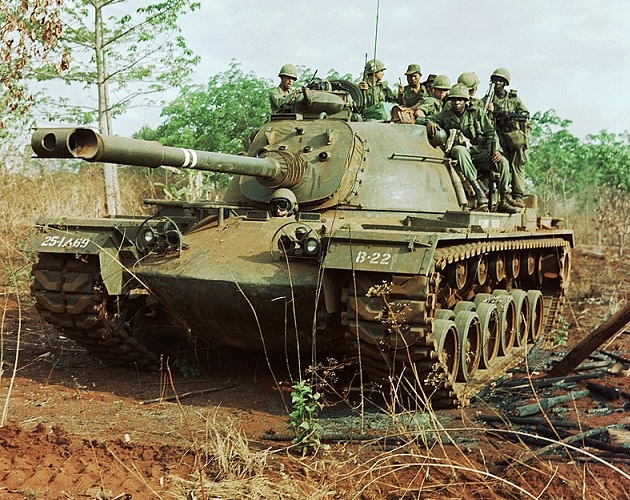
Due to the increased usage of the 1-69th Armor in securing the highway system in the Central Highlands during 1967-68, many of the battalion’s tanks had a warning in Vietnamese painted on the sides of the turret which stated “Danger, do not ride bicycles along side.” While on road security duty, tankers could relax a little when civilians were using the roads but in their absence an ambush or mortar attack could be expected.
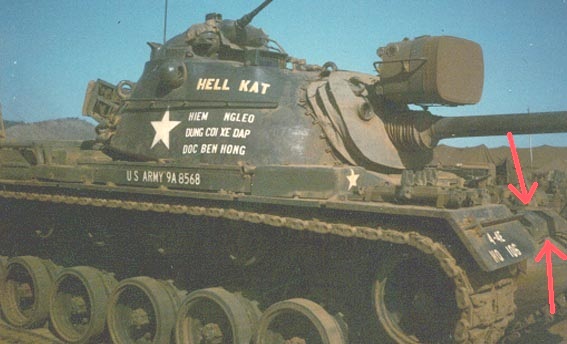
This M48A3 of Company C (3 stripes on the gun barrel) has the Vietnamese warning message painted on the turret side in a wavy line above the turret railing. Along the top edge of the turret are at least 15 kill markings. In Vietnam, the US objective was not to hold territory or secure populations so victory was assessed by the enemy body count KIA.

Since WWII, all US tanks were adapted to mount a bulldozer blade for clearing obstacles and debris while under fire. The M8A3 bulldozer blade was designed for the M48A3 Patton tank.


This M48A3 dozer tank has the name “Bad News” painted on the gun barrel fume extractor.

Film: M48 tanks fire machine guns and soldiers take out a tank stuck in dense bamboo
In the North Vietnam, there are four distinct seasons. South Vietnam has only two basic seasons, the rainy season and the dry season. The dry season in Saigon and the Southern Vietnam as well starts in November and ends in April. At the height of the southwest monsoon in June, July, and August, Pleiku, in the Central Highlands, receives an average of 51.9 inches of rain a year while Quang Tri, along the northern coastal plain, gets 63.6 inches, or over five feet, of rainfall a year.
During the monsoon season, many areas in Vietnam become extremely muddy for the heavy M48A3 tank. In some situations, a C4 demolition charge would be detonated beneath the mired tank to break the suction of the mud allowing it to be towed. No fewer than six M113 Armored Personnel Carriers (APC) linked in a daisy chain would be required to tow this M48A3 from the mud.
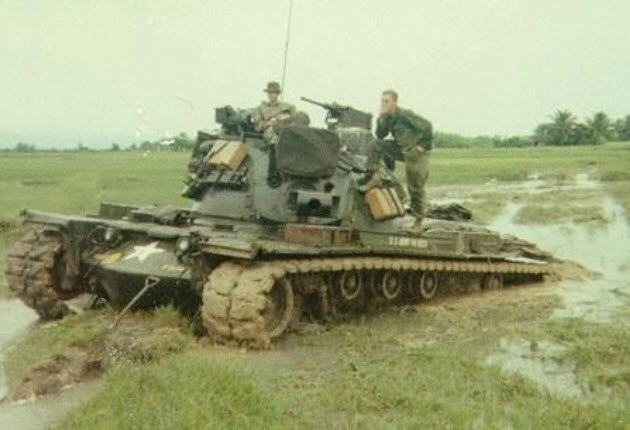
This M48A3 is navigating a swampy trail and muddy water is completely covering the front hull. That is the driver’s helmet beneath the searchlight and gun barrel.

This is the same M48A3 after emerging from the swamp with muddy water running off its front hull.

M88
The M88 Recovery Vehicle was produced by the Bowen-McLaughlin-York Company (BMY) from 1960 until 1964 with a total output of 1075 vehicles. The recovery equipment consisted of an hydraulically powered and controlled spade, main winch, boom and a hoist winch. The spade was mounted on the front hull and operated by the driver to anchor the vehicle or to support it when lifting a load with the boom. The spade also could be used for light clearing or leveling. The main winch with a capacity of 90,000 pounds was mounted beneath the crew compartment and the cable exited through a hole in the front hull. The “A” frame type boom was mounted on top of the hull and operated by the driver from his position. The hoist winch for the boom had a capacity of 50,000 pounds and was mounted below the cab with the cable passing through a cable chute between the floor of the crew compartment and cab roof. A gasoline fueled personnel heater was installed at the right rear of the crew compartment which was not used much in Vietnam. The only armament was a M2 Browning .50 Caliber MG mounted on the commander’s cupola located at the center of the crew compartment roof.
This M88 has armor shields mounted around the commander’s .50 Caliber MG which has a flash suppressor on the barrel. Note the Jerry can mounted on the inside of the open door on the side hull and a red fire extinguisher is mounted inside the hull. Painted on the gun shield is a red pegagus which is a mythical winged divine horse from Greek mythology.

M88 named “HELL’S HALF ACRE” is missing one of its road wheels along with its torsion arm assembly probably due to mine damage. Even the M88 was not immuned to mines. The road wheel is carried on the front spade. On the boom behind a ration box is a grey tool box with the number “23” painted in white.
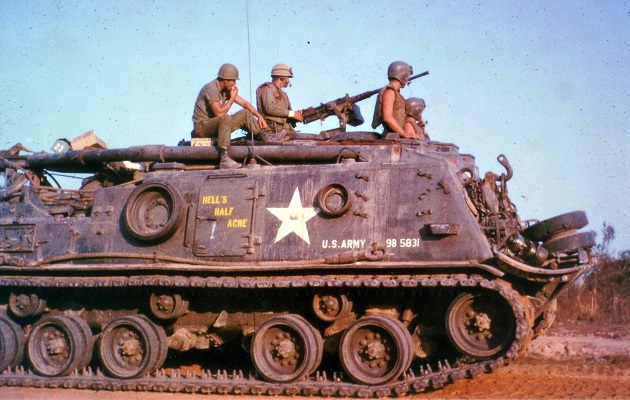
Film: M88 Medium Recovery Vehicle” 1961 US Army; R&D Progress Report No. 3
Tank commanders (TC) complained that the M2 .50 Caliber MG took up a great deal of space in the cramped cupola’s interior which caused difficulties when reloading or clearing the jammed MG during combat. Also, the M1 Commander Cupola was originally designed with only three vision blocks which had blind spots. The late model M48A3 introduced the G305 cupola riser with 9 non-removable vision blocks which provided the TC with 360 degrees field of vision.

The G305 cupola riser improved the vision problem for the TC but did not solve the problem of the cramped cupola. Many TCs had the M2 MG removed from the cupola and mounted it on top of the cupola. This was done as a field modification and there was no standard method of how the MG was mounted. Usually, it was mounted on a simple pintle mount. This M48A3 has the MG mounted on top of the cupola with a modified M3 tripod. Draped along the front of the cupola is a string of smoke grenades. The TC is sitting on the open cupola hatch.
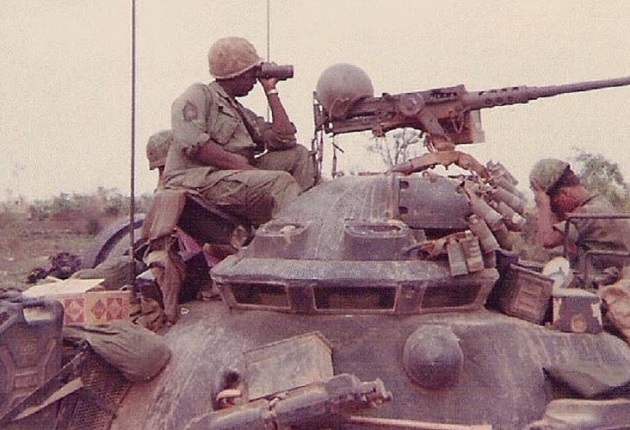
Tết Offensive 1968
The name of the offensive comes from the Tết holiday, the Vietnamese Lunar New Year. Prior to 1968, there was an agreed cease fire during the Tết holiday but in 1968 that changed. On 30 January 1968, the VC and North Vietnamese Army (NVA) launched a major offensive against the South Vietnamese Army of the Republic of Vietnam (ARVN), the US and their allies which became one of the largest campaigns of the war. The campaign was surprise attacks against military and civilian command and control centers in more than 100 towns and cities throughout South Vietnam.
Huế
On 31 January 1968, several NVA and VC regiments attacked the city of Huế (Vietnamese: [hwě], pronounced “wade”). Huế’s buildings and its main landmark, a vast 19th-century citadel, surrounded by a moat and thick stone walls provided ready-made defensive positions for the communist invaders. The ARVN 1st Infantry Division HQ located at the north eastern corner of the citadel reacted to the attack and called in additional units from the surrounding areas. Several companies of the 7th ARVN Armored Cavalry Battalion (M41 tanks) were virtually wiped out while undertaking three stubborn attacks from the southern outskirts of Huế, up Highway 1 towards the bridge that spanned the Perfume River.

The MACV Advisory Team commander called for help from the closest US base which was at Phu Bai, on Highway 1, about 17 km south of the city. Elements of Alpha Company, 1st Battalion, 1st Marine Regiment (Alpha/1/1) advanced north up Highway 1 escorted by two US Army trucks mounting quad .50 Caliber MG mounts. Three km south of the MACV, Alpha/1/1 ran into a platoon of five Marine M48 tanks of Alpha Company, 3rd Tank Battalion, which were on their way north to the Hue LCU Ramp for transportation north to the DMZ. The Marine tanks orders were changed and they accompanied the Alpha/1/1 Marines into the intense fighting in Huế.
A Marine M48A3 supporting Hotel company, 2nd Battalion, 5th Marine Regiment (Hotel/2/5) fires its 90mm gun at a distance target. Note the seven ejected shell casings on the ground beside the tank.

M67
The Flame Thrower Tank M67 (also known as the “Zippo”, nicknamed after a popular brand of cigarette lighter) was the medium flame tank that was used by the US Marines in Vietnam. The M67A2 Zippo tank was built on the M48A3 hull and 76 were converted during 1963-64 at the Anniston and Red River Army Depots. It was the last flame thrower tank used in US service.
The M67 had no cannon. The M6 flame gun was installed in a shroud designed to resemble a 90mm gun, although shorter and slightly larger in diameter. The dummy gun tube also had holes in the side to permit air to enter for combustion and holes and drip shields in the bottom for drainage. A .30 Caliber coaxial MG was mounted to the right of the flame gun. The loader was eliminated reducing the crew to three. The tank commander and gunner remained in their usual positions with the same seats as in the M48.
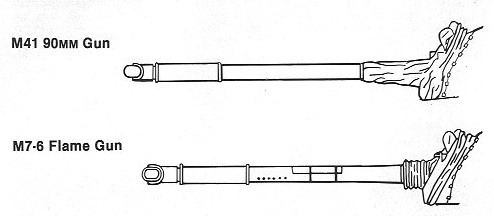
The only topside entrance to the turret was through the commander’s cupola as the loader’s hatch was used to access the flame thrower fueling and charging controls. The thickened fuel for the flame gun was stored in the main fuel container located in the left center of the turret. A 10.2 gallon secondary fuel container supplied unthickened gasoline to the atomizer for starting. Both the main and secondary fuel systems were pressurized to 325 psi. The main fuel container had the total capacity of 398 gallons, but the necessity of leaving room for expansion and other losses reduced the the usable capacity to 365 gallons. This permitted a total average firing times of 55 seconds for a 7/8 inch nozzle and 61 seconds for a 3/4 inch nozzle. On the M48, the auxiliary engine muffler was mounted on the rear deck. On the M67, it was relocated to the right rear fender to prevent interference with the flame thrower fuel tank vent which protruded through the bottom left of the turret bustle.
Refugees are passing M67A2 number USMC 211227 fleeing the Communist held areas on 3 February 1968. Two flame tanks supported the Marines as they cleared the streets house to house.
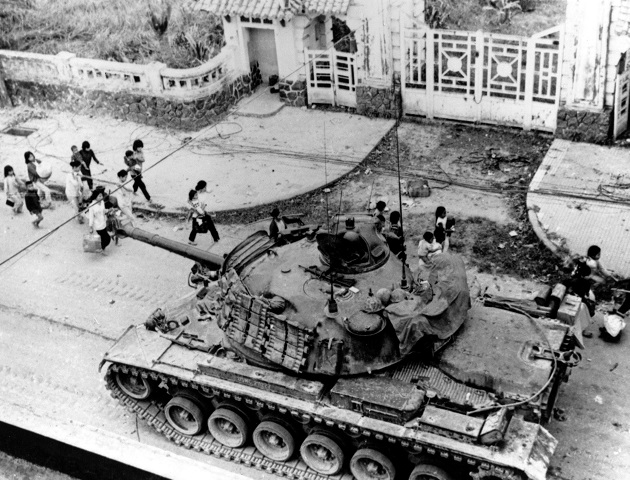
This is a color photo of the same M67 tank above on Tran Cao Van street southwest of Highway 1. In the back ground is probably the gate of the Jeanne d’Arc High School.
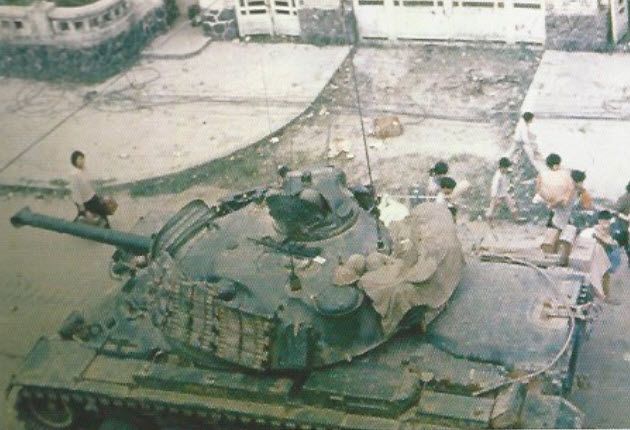
NVA troops occupying the buildings in the background fired upon the Marines and the M67 gave a warm response sending a stream of flames over the gate.

This is a color photo of the same flame attack above. While firing in quick bursts, the M67’s firing was described as “rods of flames.” You can almost feel the heat.
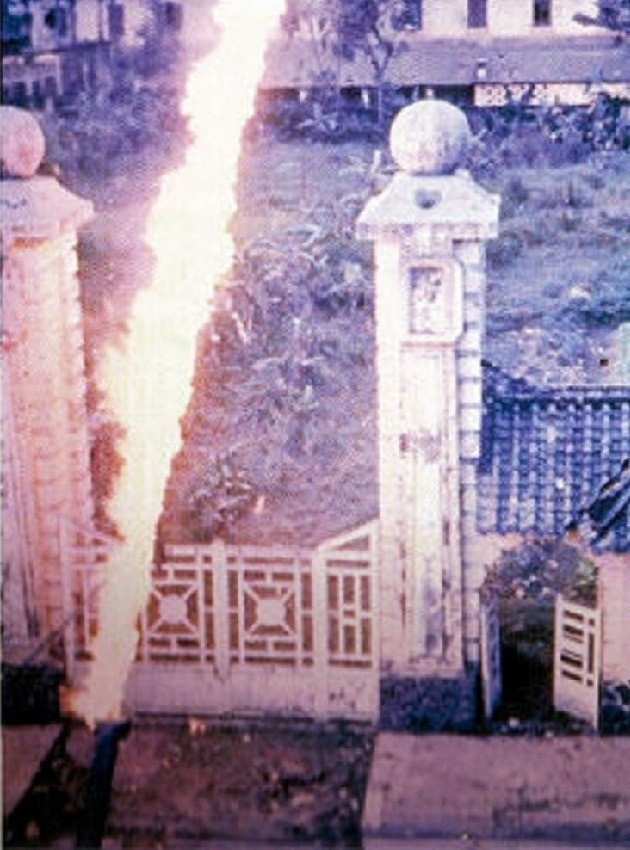
This is a street view of the action with Marines of Fox Company, 2nd Battalion, 5th Marines (Fox/2/5) watching for the NVA.

FIGHTING IN THE CITADEL
On February 1st, the 1st ARVN Airborne Battle Group consisting of the 2nd and 7th ARVN Airborne battalions and an armorer cavalry troop breached the NVA defenses with the aid of ARVN 105mm howitzers and entered the 1st ARVN Divison command compound. US Marine helicopters then airlifted additional ARVN units directly into the command compound. On February 2nd, as the 9th ARVN Airborne Battalion airlifted directly into the 1st ARVN Divison command compound, the division’s elite Blank Panther (Hoc Bao) Company led an attack force that included the 2nd and 7th ARVN Airborne battalions to retake the Tay Loc Airfield and the ordnance compound. More ARVN reinforcements entered the Citadel and heavy fighting between the ARVN units and the NVA continued for over a week.
REINFORCING THE CITADEL
On February 10th, two reinforced Vietnamese Marine Corps (VNMC) battalions and a fresh US Marines infantry battalion were ordered for duty in the Citadel. The US Marine battalion was the 1st Battalion, 5th Marines (1/5) reinforced by a platoon of five 1st Tank Battalion M48A3 gun tanks that made the trip from Da Nang aboard LCUs. On February 12th, the 1/5 Marines and the supporting tanks crossed the Perfume River aboard LCUs that put them ashore at a secure quay beside the ARVN-held northern corner of the Citadel and they reached the 1st ARVN Division command compound.
According to the ARVN General Staff, the 1st ARVN Airborne Task Force held a solid line about halfway down the northeastern wall, a line that stretched southwest along Mai Thúc Loan street from the Dong Ba Gate (today named Cửa Chánh Đông which translates to “East Gate”) to the north corner of the Imperial Palace of Peace.
This is a map of the Citadel. The Green Dot in the lower right hand corner is the approximate location of the M67 tank incident. The green line marks Mai Thúc Loan street which leads to the Dong Ba Gate (Red Dot). The blue line marks Tinh Tam Street.
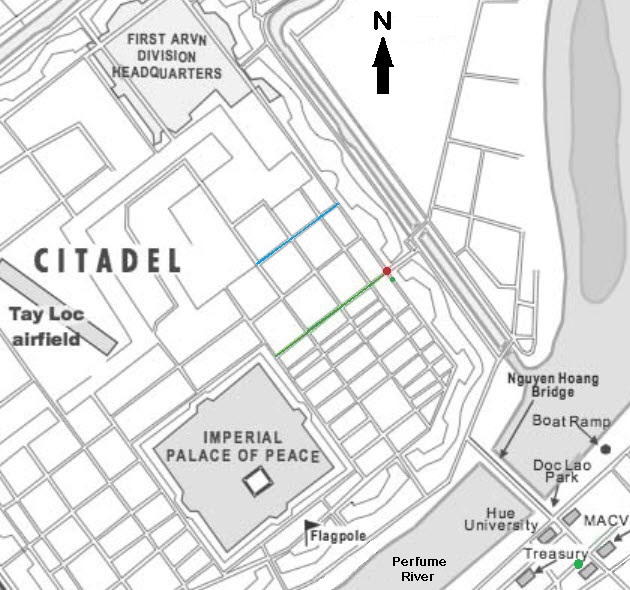
At dawn on February 13th, the 1/5 Marines marched out of the 1st ARVN Division command compound in columns of companies. The leading company was Alpha/1/5, followed by Charlie/1/5. The battalion command group then followed with Bravo/1/5, in reserve, bringing up the rear of the column. At 0800 hours, Alpha/1/5 approached the ARVN line from the rear in two columns. About 100 meters southeast of Tinh Tam Street, just as the point man was approaching the wall of the Dong Ba Gate, a group of ARVN soldiers climbed down from positions atop the wall. They just laughed and smiled as they passed by the Marines.
This M48A3 of 3rd Platoon, Company A, 1st Marine Tank Battalion is about to move forward to the 1/5th Marines line of departure. Marines are unloading from a truck immediately behind the tank and taking up positions around the tank.

This is my close up of the M48A3’s Xenon searchlight which bares the name “THE ORIGINAL FLOWER CHILDREN.”

When the Marine point man reached the base of the Dong Ba Gate and tower, he turned right (southeast) and crossed in front of the entryway. The second Marine in the column also crossed in front of the entryway. As the third Marine stepped across, it started to rain grenades from atop of the wall. All hell had broken loose. Heavily armed NVA troops occupied the Dong Ba Gate, tower, and the surrounding wall. The Marines took heavy fire and took heavy losses. The Marines were stunned to have run into such strong enemy opposition so far behind the ARVN Airborne Task Force’s front line. After radio inquiries, it became apparent that the ARVN Airborne battalions had withdrawn from their advance positions during the night and elements of the 6th NVA Regiment had moved into the vacuum.
While the Marines groped to find weak spots in the enemy line across their front, the NVA soldiers brought RPGs and other heavy weapons to bear. The Marines responded in kind and a Marine M48A3 tank was called forward. It fired five 90mm rounds into the tower with no noticeable effect. The fighting was both sustained and intense. The tanks were in constant demand, often expending their complete ammunition loads within a few hours. Although struck repeatedly by RPGs, they continued to fight despite extensive damage, especially to optical equipment and radio antennas. Some tank crews were so shaken by multiple hits that crew members were changed as often as once a day.
This a view of the Dong Ba Gate and the tower from a second floor building on Mai Thúc Loan street. At the time this photo was taken on February 14, both were still occupied by NVA soldiers.

Front view of M48A3 with the name “MAD HARLOT” painted in flawless Gothic Script on the gun barrel. The number A51 indicates the tank of Alpha Company commander while the tactical insignia on the glacis plate indicate the 1st Marine Tank Battalion. Just forward of the coincidence rangefinder ‘rabbit ear’ is a body count of two leering oriental faces in yellow wearing conical hats with red stars. The location is on Đường Xuân 68 street, southeast of the intersection with Mai Thúc Loan street. The wall to the right is the outside wall of the Citadel and behind the tank down the street to the right is the Dong Ba Gate and the tower.

This is the left side view of the M48A3 number A51. Note the Citadel wall to the left and on the tank the double Jerry cans mounted on the turret and the ammunition can and two Jerry cans on the rear fender.

This is a color photo of M48A3 number A51 taken further behind the tank. Note the Citadel wall to the left, the double Jerry cans mounted on the turret and the ammunition can and two Jerry cans on the rear fender. The lower hull and engine deck is covered with dried red dirt which was common in Vietnam. The trees in the background down the street are exactly the same in these two photos.

This is the location today on Đường Xuân 68 street.

Stars and Stripes newspaper photographer John Olson took this color photo of M48A3 “MAD HARLOT” sometime during or after the fighting in the Citadel. Note the pile of shell shipping tubes on the ground behind the tank on the left. It indicates the crew was in the process of reloading 90mm rounds.

This is my close up showing the details of the commander’s cupola. Here the M2 MG cradle was turned up to its maximum elevation and a .50 Caliber MG tripod was mounted in the open hole. This is a good view of the the G305 cupola riser and the disruptor bar in front of the commander’s cupola. The disruptor bar was designed to prevent the cupola MG fire not to hit the searchlight.

This is my close up showing the details of the turret side. It appears to be covered with rust and Vietnamese red dirt.

This is my close up showing the details of the searchlight and the gun barrel. Someone has placed a Vietnamese Bai Tho conical hat on top of the muzzle break for the photo. The chin strap can be seen dangling from the hat.

Film: Tanks at barrier on bridge fire and bazooka team loads and fires during Tet
The city of Huế was declared secured on 26 February 1968. For all official news marking “the end” of the battle. Bloody combat in and around Huế continued against stubborn Communist units and stragglers for, in some areas, another three weeks.
Battle of Kontum (30 January to 12 February 1968)
The 24th NVA Regiment, 304th VC Battalion and the 406th Sapper Battalion attacked the MACV compound, post office, airfield, and the 24th ARVN STZ headquarters in the city of Kontum in the Central Highlands near the borders of Laos and Cambodia. The initial enemy assault was met by two Montagnard scout companies which were rapidly brushed aside and the 2/42nd ARVN Regiment which fell back. The B-24 Special Forces Detachment compound was penetrated at several points. A composite task force consisting of ground elements of the 7/17th Air Cav; 1st Battalion, 22nd Infantry, US 4th Infantry Division, supported by M48A3s of Company C, 1-69th Armor advanced into the heart of the city and endured fierce urban fighting for 14 days.
1-69th Armor crewmen sleeping in hammocks swung from the side fender of their M48A3 during the Battle of Kontum.

Film: US 1st Infantry Division soldiers check a destroyed M-48 Patton tank
A M48A3 of the 1st Battalion, 77th Armor Regiment attached to the 5th Infantry Division (Mechanized) ford the Cam Lo River, south of Con Thien, late 1968. The 77th Armor Regiment lineage started in WWII as the 753rd Tank Battalion where its first combat was during Operation Husky in Sicily 1943.

M48A3 C-35 of Company C, 1-69th Armor still has sand bags as additional armor on the front hull while supporting the 4th Infantry Division in 1967 or early 1968. The tank was named “CHARLIE BROWN” from the Peanuts comic strip by Charles Schulz. The large boxes on the turret sides were 20mm ammo boxes used for storing personal gear and C-rations boxes on top of the turret were chained down to prevent thief. Note that a horseshoe is hanging from the gun barrel probably for good luck.

This is M48A3 C-35 on strong point duty on Highway 1 near Bong Son in 1968. The tank crews referred strong point duty as “Lazy Days”. Vietnamese kids were usually around to take handouts, help with small jobs, or sell items. The crews could buy beer, soda, and ice since they were no where near a PX and there was nothing else they could spend their money on. They also knew that information about them were being passed to the VC but if they did not keep the locals happy they could find themselves in a very difficult spot. Note the civilian van passing on the road in the background.

This is a close up photo of M48A3 C-35. Painted on the searchlight cover is the Peanuts comic strip character “Snoopy” who was Charlie Brown’s dog. Here Snoopy is pretending to be a fierce vulture perched on a tree branch which appeared in the comic strip on 18 July 1967.
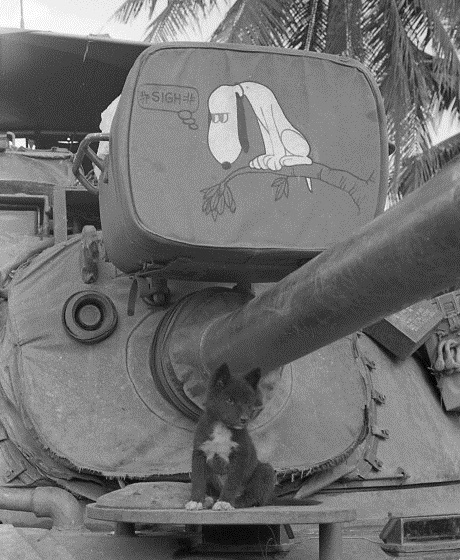
This is M48A3 C-35 stuck in the mud south of Bong Son. The angle of this photo clearly shows the number of ammo cans carried on the fenders. Lashed to the top of the searchlight is an E-8 tear gas launcher which was used to suppress the enemy. The E-8 was a suitcase size rectangular fiberglass launcher about 2 feet long with 8 tubes in it, each held eight 35mm tear gas projectiles. It was able to shoot all 64 CS grenades in four 5-second bursts of 16 each, about 250 meters, covering an area about 50-100 yards wide with CS gas. Note on top of the E-8 launcher is a helmet (probably NVA) with a peace sign painted on it.

Another M48A3 of Company C, 1-69th Armor, C-32 named “CONSPIRACY” is also stuck in the mud near Bong Son. On the searchlight cover is Snoopy sitting on his doghouse pretending to be a WWI pilot fighting the Red Baron and the caption read “WAR IS HELL.” At that time, the company symbols were painted on the turrets for quick identification, A square for Alpha, a diamond for Bravo and a circle for Charlie company. The Egyptian ankh painted below the company symbol was later over painted.

This M48A3 is patrolling a perimeter road near Chu Chi in January 1969. Note the ammunition cans stored on the fenders, ration boxes stacked on the turret and the roll of cyclone fencing on the rear deck. The driver has “POT LUCK” painted on his helmet. On the Xenon searchlight cover is the image of the 1950-60s comic\cartoon character “The Road Runner” sounding his characteristic “Beep Beep”.

BEN HET
During the night of 3 March 1969, three M48A3 tank crews of the 1st platoon, Company B, 1-69th Armor was stationed on the hill west of the Civilian Irregular Defense Group (CIDG) camp at Ben Het (north of Pleiku) had heard noises from unidentified vehicles below their position for about 30 minutes. The noises were clanking of tracks and heavy engine growl of enemy tanks. Then suddenly, an enemy tank detonated a land mine which pinpointed its position only 1200 yards (1097 meters) from their position. The NVA tank swung its gun towards the M48A3s and began firing. The M48A3s opened up with their 90mm guns with only the muzzle flashes to sight on. The NVA tank scored a direct hit on the turret of an M48A3 which killed two crewmen and wounded the other two. The second 90mm round fired found its mark and the NVA tank exploded. Then a second NVA tank was spotted on the road behind the burning tank. It was using the burning tank to cover their muzzle flash. A M48A3 tank gunner took a sight off one of the flashes and then fired the 90mm. The second NVA tank exploded a second later. The tank duel ended with 8 of 10 NVA tanks and several APCs retreating across the border into Laos or Cambodia, harassed by USAF fighter-bombers and artillery from nearby fire bases.
The camp was attacked by the NVA 66th Regiment supported by 4th Battalion, 202nd Armored Regiment. The 202nd was tasked with destroying the camp’s 175mm SP guns. This was the only tank vs tank engagement between US and NVA armor during the Vietnam war.
At daybreak, the battlefield revealed the wreckage of two PT-76s and one BTR-50 APC. This is the NVA PT-76 which was retrieved from the battlefield. The US 90mm tank round penetrated the top of the engine deck resulting in the destruction of the vehicle.

This is a front view of the NVA PT-76.

The knocked out NVA PT-76 was loaded on a lowboy trailer for transportation to Pleiku. The US victors painted the graffiti on the captured NVA tank.

An M48A3 (Late Model) of 1st Squadron, 11th Armored Cavalry Regiment undergoes maintenance in the field at Quan Loi in 1969. Note the covering of red dirt on the tank.
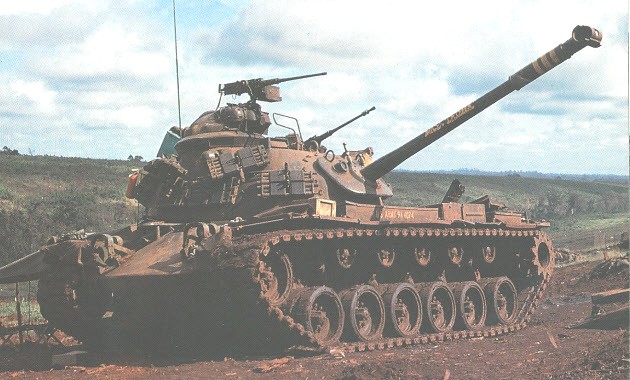
The US M60 Main Battle Tank did not serve in Vietnam but two of its variants did, the M728 CEV and the M60 AVLB.
This M728 Combat Engineer Vehicle (CEV) of the 919th Engineer Battalion, 11th ACR is parked among trees near Quan Loi in 1969. It was armed with a 165mm M135 short-barreled demolition gun with 30 rounds of HEP (high explosive, plastic) ammunition and was fitted with a M9 Dozer Blade. A winch and retractable A-frame crane was mounted on the turret for lifting, carrying and winching operations.

This M48A3 named “Wild One 4” was operated by the 919th Engineers as additional protection while brush clearing, building bridges and especially when clearing the roads of mines which were under the constant threat of an ambush.

This is an earlier photo of M48A3 “Wild One 4”. Note the front fenders are still intact.

This is another photo of M48A3 “Wild One 4” with a damaged right track probably caused by a mine. Next to it is another M728 CEV without its dozer blade mounted.

The new M551 Sheridan arrived in South Vietnam in January 1969 accompanied by factory representatives, instructors, and evaluators and the new tanks were issued to the 3rd Squadron, 4th Cavalry Regiment and the 1st Squadron, 11th ACR for field testing. Eventually, all US armored cavalry units (except the 11th ACR, which retained its M48 tank companies) received M551s replacing their M48A3s which in turn were eventually given to the South Vietnamese Army. The US tank crews were not pleased with the M551 due to its high casualty rate as mines and RPGs that would only damage the M48A3, would totally destroy the M551.
The M48A3 on the left only received damage to its tracks and road wheels while the M551 on the right was destroyed where its hull ruptured from the explosion.

On the other hand, the 52 ton weight of the M48A3 was sometimes a problem.
This M48A3 locked its tracks while crossing this Bailey Bridge near Ban Me Thuot in 1968.

While crossing a pontoon bridge near Quang Tri in 1969, a section of the bridge collapsed from the weight of this M48A3 and the tank ended up on its side in the water. Recovering this tank would probably be a difficult task.

The M48A3 was the standard US tank used in Vietnam but due to high armor losses during and after the Tet offensive, a number of the M48A2 tanks were employed to some US armor units in Vietnam. They were unpopular with the crews due to their gasoline engines. Mines and RPGs had little effect on the diesel powered M48A3 whereas the gasoline fueled M48A2 could turn into a flaming torch within seconds. The M48A2 tank only had three return rollers while the M48A3 had five and the M48A2 did not have the large box shaped M60 type air filters mounted on the rear fenders.
The 1-77th Armor received 67 M48A2C tanks (23 supplied from US Army Training Center at Fort Knox and 44 from the Letterkenny Army Depot). The 1-77th Armor used them from August 1968 to January 1969 and then they were replaced with M48A3s. The M48A2C was a M48A2 fitted with the improved M13 fire control system and some late model turret improvements.
This M48A2 was attached to the 5th Infantry Division (Mechanized) during Operation Fisher on 6 January 1969.

This is my close up the turret of the M48A2 in the above photo. Behind the center track links hung on the side of the turret is painted an image and part of a name or slogan. The letters “NE” are visible just above the track links next to the soldiers boots and towards the rear of the turret just forward the lifting rings is a square tactical sign.
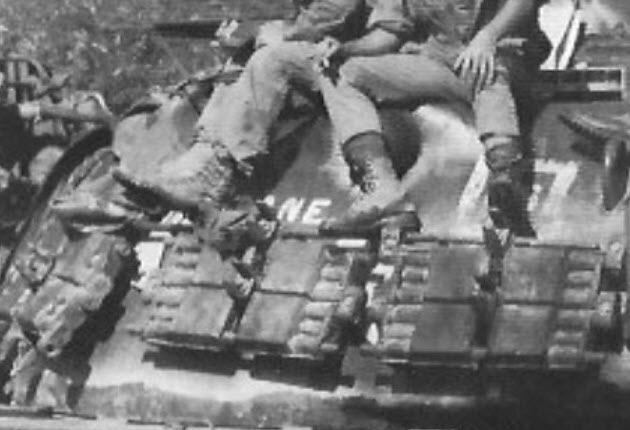
This tank named “Willie” has been incorrectly captioned as being an early M48A3. It was assigned to A troop, 4th Squadron, 12th Cavalry, 1st Infantry Brigade, 5th Infantry Division (Mechanized) and was deployed along Highway 1 in August 1968.
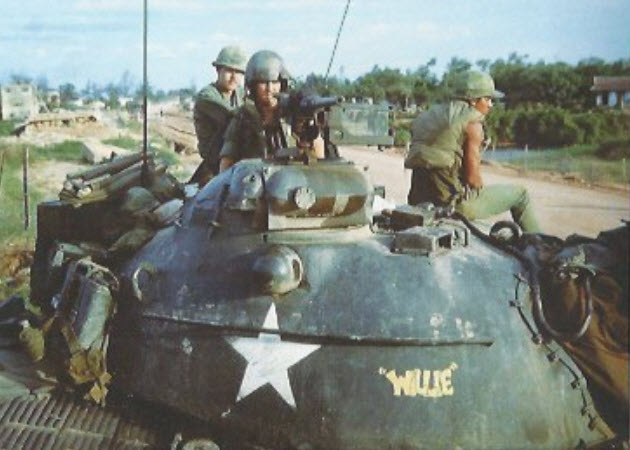
This is a side view of “Wille.” The three return rollers and the missing large box shaped M60 type air filters on the rear fender indicate that this is a gasoline fueled M48A2. The name on the gun barrel fume extractor is illegible.

This another incorrectly captioned M48A2 attached to the 5th Infantry Division (Mechanized) moving up a beach in the Quang Tri Province during Operation Fisher on 6 January 1969. Note the unusual length of five track links on the side of the turret.

The other M60 variant used in Vietnam was the M60 Armored Vehicle-Launched Bridge (AVLB) based on the M60A1 chassis along side the M48 AVLB. These AVLBs were attached to the 5th Infantry Division (Mechanized) during Operation Utah Mesa in the northwest Quang Tri Province from 12 June to 6 July 1969.


Film: Vietnam War – 11th Armored Cavalry Regiment 250195-06
Film: Operations of 11th Armored Cavalry Regiment – H1916-03
Film: 9th Infantry Division in Cambodia (May 8-14, 1970)
Bunker busting: These M48A3s (Late Model) of 2-34th Armor make short work of an enemy bunker system near Chu Chi in February 1969. Once detected, the enemy positions were destroyed to prevent further use by the enemy either by explosives or, just effectively, by being crushed under the tracks of a couple of 52 ton tanks.

The Blue Scooter Plunder
On 4 May 1970, the 2nd Squadron, the 11th Armored Cavalry entered Snoul, Cambodia (north of Phenom Penh) which was known to military intelligence (S-2) as being a Rest & Recuperation (R&R) center for the NVA. While moving towards the village, the tanks began to take heavy AK-47 cross fire from unknown locations. The Platoon Sargent called in for an air strike, waited about five minutes for the jets to show up, then another few minutes for the actual bombing during which time the NVA troops evacuated the village. Then the tanks entered the village without opposition, with guns a blazin’, to survey the devastation, and added to it. A two story bar, from which they looted some cases of orange soda, had been destroyed; there were some burned out cars; and some houses were completely obliterated from the air strike. They took no chances and began to shoot up the place. Then they found a brand new, baby-blue motor scooter parked with kick-stand down outside a building that was partially destroyed from the air strike. The Platoon Sargent then said, “Get it, they’ll just run RPGs back to Vietnam with the damn thing.” So, a couple tankers dismounted and hoisted the pristine machine on the back deck of the tank, lashed it down, and they continued on their way. With all the media attention the invasion attracted, the tankers were ordered to take along a reporter who did not like GIs or the war. This reporter had witnessed the event.
The scooter accompanied the tank crew to the next base camp where one of the Chu Hoi defectors, whom no one trusted, took it and supposedly rode it to Saigon to see his girlfriend. He was gone for more than a week then returned at about the same time when they got orders all the way from the pentagon to return the scooter to the exact same spot where they had gotten it. The accompanying reporter had written a story about it in the states and it resulted in the order to return it. So they loaded the slightly less virginal machine back on the back deck of the tank for the trip back to Snoul which was about ten klicks. The tankers did not like the order to take the scooter back to Snoul because it was risky since they shot up the village weeks earlier and this time they would only have one tank platoon and without any air support. So they proceeded towards Snoul and when they reached a grass air strip just outside Snoul, the Platoon Sargent stopped the column in the middle of the air strip and gave the command “Throw it off right in the middle of the air strip.”
The two original thieves untied the lashing that held the scooter on the tank’s back deck and kicked it off. The driver then backed up one track right on top of the scooter and did the shimmy, twisting the steering wheel left to right, right to left, left to right. After he drove off, each of the other tanks in the platoon followed suit, driving one track on the once pristine scooter, then doing a twist. Fifty-two tons of steel had flatten the Japanese made motor scooter like a pancake. They avoided the village and took another route back to the base camp. When they got back, the Platoon Sargent walked up to the Company Commander, saluted and announced, “Mission Accomplished.”
Complete Story: The Baby-Blue Scooter of Snoul, Cambodia
US and ARVN soldiers try to start a looted motor scooter near Snoul, Cambodia, 9 May 1970.

To speed up the process of clearing mines, a Tank-Mounted Expendable Mine Roller ENSURE 202 was designed to exert high ground pressure without crushing roads and bridges.

This M48A3 equipped the ENSURE 202 mine roller was operating on Route 19 in August 1970. The name “Butch” is painted in front of the driver’s hatch and note the star on the front hull was over painted black.

This M48A3 has added some additional protection. The large umbrella protected the turret crew from the pouring rain and the hot sun. For additional firepower, twin M2 Browning .50 Caliber MGs with flash suppressors was mounted on top of the commander’s copula.
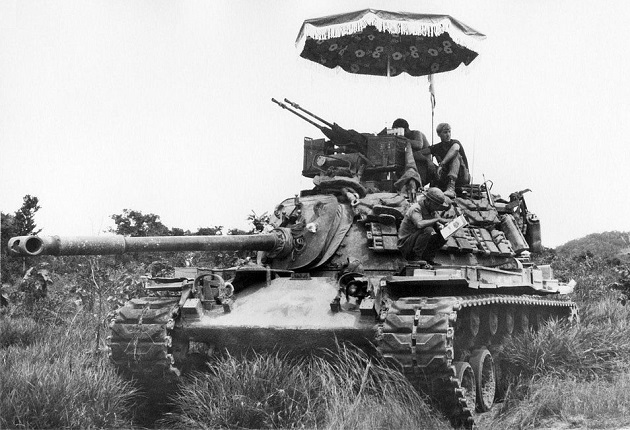
The mouth with sharp teeth and the eyes on this M48A3 are reminiscence of the colorful fearful markings applied to US tanks during Operation Ripper in 1951 Korea but in Vietnam there were no such orders.
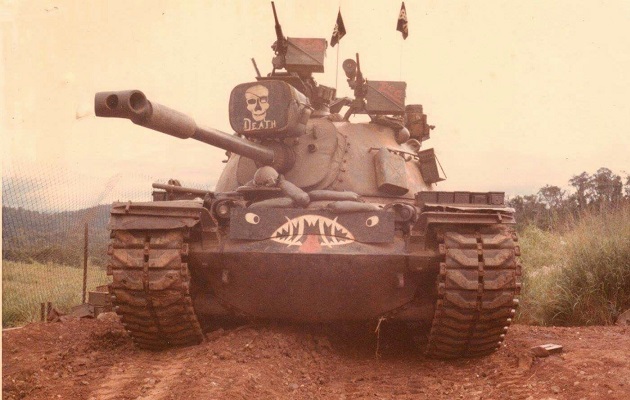
M48A3 tank named “Zig Zag Men” of the 1/10th Cavalry supporting 1/22nd Infantry, 4th Infantry Division at LZ (Landing Zone) Action, 1971. The fire base was situated along Highway QL-19, just outside the Mang Yang Pass (Mang Giang Pass).

A M48A3 tank with the name “FUJIGMO” on the gun barrel. The term was appropriate for US soldiers who were “short” (their tour was coming to the end) and they received their long awaited orders to rotate back to the states. The acronym stood for “Forget You Jack, I’ve Got My Orders.” (Polite version) which was a common slang dating back to WWII. Note that the MG mounted on top of the commander’s cupola is a Browning M1919A4 .30 Caliber MG.
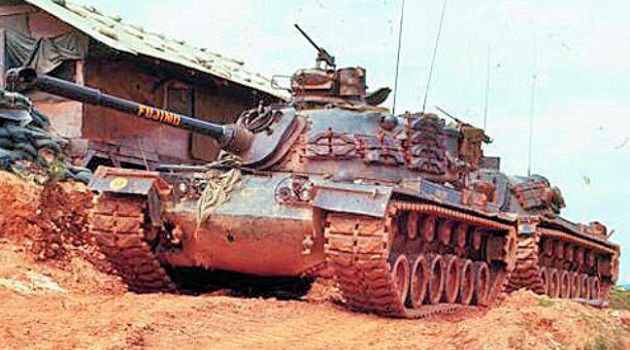
Easter Offensive 1972
The Army of the Republic of Vietnam (ARVN) first tank regiment, the 20th Tank Regiment, was formed at Quang Tri in 1971. The unit received 54 M48A3s from departing US armor units but it lacked bridging equipment and tank recovery vehicles.
After the last US ground units left Vietnam, the North Vietnamese Army (NVA) launched an all-out invasion of South Vietnam along three fronts. Three NVA infantry divisions and two armored regiments attacked across the DMZ on 30 March 1972. The forward ARVN fire bases were quickly overrun. The ARVN 7th and 11th ACR supporting the 147th ARVN Marine Brigade continued to resist around Dong Ha on the south bank of the Cam Lo River. Then it was decided to commit the new 20th Tank Regiment to repel the NVA offensive.
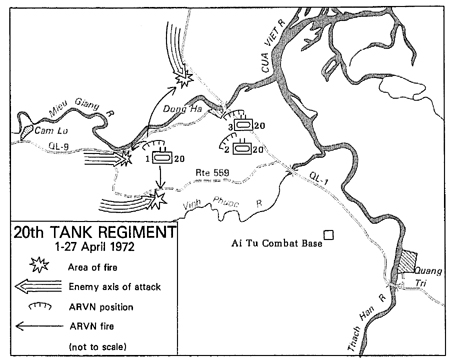
On April 2, a squadron from the 20th Tank Regiment engaged a NVA armor column in a long range shooting match west of Dong Ha and destroyed 2 T-54s and 9 Type 63 tanks ( a Chinese amphibious light tank) with no losses of their own. On the morning of April 2nd, US Navy aircraft spotted a group of enemy tanks moving through an open area between Cua Viet and Cam Lo, and after that 12 T-54s and 8 PT-76 tanks were also located in the surrounding area. As soon as intent was determined, US naval 127mm (5″) guns fired upon the tanks, causing heavy damage to the enemy and forced them to disperse. The US Military Aid delegation to Vietnam calculated that by April 3, three offshore US Navy warships had fire over 1400 rounds to assist the ARVN military. On April 9, the 20th Tank Regiment with two squadrons from the 17th ACR (M41s) faced another NVA armor assault and destroyed 16 more T-54s and captured a running Type 59 tank, again without any losses of M48A3s.
Film: SYND 9-4-72 DONG HA SITUATION
In an effort to break the deadlock, the NVA moved up additional infantry and armor. To counter the NVA, the ARVN moved up all of the 1st Armored Brigade to the front line with the 4th, 11th, 17th ACRs and the 20th Tank Regiment. The 18th ACR sent by Military Region 3 was directed to Dong Ha.
An ARVN 20th Armor M48A3 in position along the southern bank of the Mieu Giang River west of Dong Ha.

ARVN M48A3s of the 20th Armor Regiment in positions along Highway 9, 10-13 April 1972.

ARVN troops and an M48A3 eight miles west of Dong Ha watch smoke billow skywards as a B-52 air strike hit a NVA tank column attacking their position on 11 April 1972. The air strike knocked out 27 NVA tanks, 3 artillery pieces, and wiped out about 100 enemy troops.
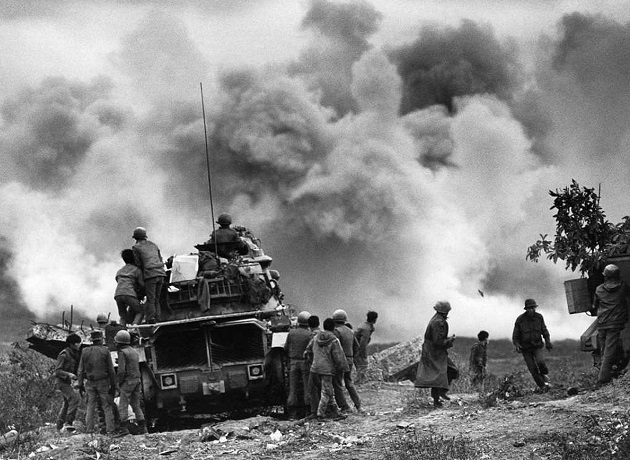
On 23 April 1972, the NVA employed the wire-guided 9M14 Malyutka anti-tank missiles (NATO reporting name: AT-3 Sagger) for the first time in the war. Three M48A3s were knocked out and other ARVN vehicles were damaged. Also, constant NVA artillery barrages took its toll on the ARVN armored vehicles.
On April 27, the NVA launched a new offensive against Dong Ha and the ARVN units were forced to retreat. The ARVN withdrawal was carried out without panic but the lack of supplies and spare parts caused a number of tanks and M113 APCs to be abandoned. After retreating for five days, the 1st Armored Brigade arrived at Quang Tri and dug in. Soon the town had to be abandoned and the ARVN units continued their orderly withdrawal south. The month long battles drained the resources on both sides and the front line once again stabilized. In the retreat, 1st Armored Brigade lost most of its equipment notably the 20th Tank Regiment which lost all of its M48A3s. Some were knocked out by rockets or artillery but the majority either broke down, ran out of fuel or were cut off when bridges were blown. In return, the 20th Tank Regiment claimed over 90 NVA tanks destroyed.
The second NVA offensive was directed at the city of Kontum in the Central Highlands. The local commanders of the 2nd Armored Brigade deployed the 14th ACR and a tank squadron of the 19th ACR in static positions at Ben Het, Dak To II and Tan Canh. On April 23, the NVA infantry armed with AT-3 Sagger missiles attacked Tan Canh. Within moments, all the M41A3 tanks deployed there were knocked out and followed by an assault of 18 T-54s which routed the local defenders. Another tank assault was launched against the other outposts and Kontum itself. The battle lasted for three months but the ARVN infantry held their ground with the aid of US/ARVN air strikes and the 8th ACR. In July 1972, the 2nd Armored Brigade with the 3rd, 14th, and 19th ACRs, counterattacked and relieved the siege.
A former NVA Type 59 tank captured by ARVN troops on 4 July 1972.
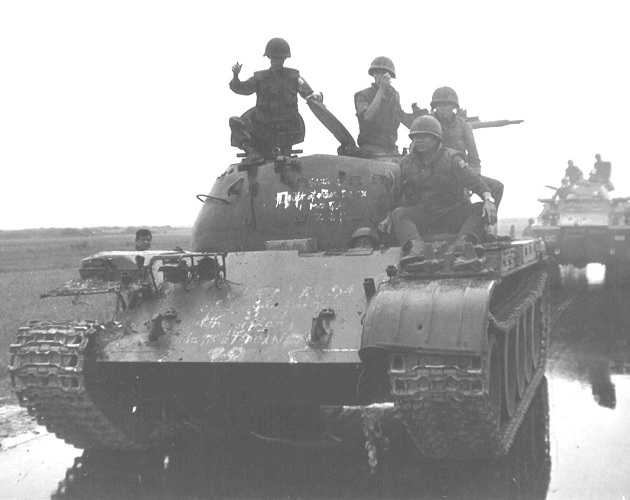
Film: 8/7/72 ARVN TROOPS ADVANCE ON QUANG TRI
(This film includes scenes of a destroyed NVA T-34.)
The third NVA offensive took place against the provincial captial of An Loc (near Saigon) after capturing Loch Ninh. The AVRN 3rd Armored Brigade lost many of its M41 tanks and M113 APCs from the 5th and 10th ACRs. In August 1972, the 3rd Armored Brigade fought its way up Route 13 to relieve An Loc destroying some remaining NVA T-54s which escaped the air strikes. Supporting the brigade was the new 22nd Tank Regiments equipped with M48A3 tanks which was formed around Saigon.
Film: ARVN M113 and M48 in 3rd Corps
An ARVN soldier with an M16 rifle slung over his shoulder on a bicycle pauses to look at a M48A3 (probably of the 22nd Tank Regiment) which was about to move up to support An Loc city’s defenses.

The 1st Armored Brigade was reorganized and re-equipped. In early September, the ARVN launched a counterattack from Hue to retake Quang Tri. The assault began with an amphibious operation launched by an ARVN Marine brigade with a newly created battalion equipped with LVTP-5s and M113s. The ARVN Marines landed behind the NVA lines and soon linked up with the tanks and APCs from the 11th, 17th and 18th ACRs of the 1st Armored Brigade. With the resurrected 20th Tank Regiment leading the way, Quang Tri was retaken on 16 September 1972.
After the cease-fire on 28 January 1973, the ARVN armored formations were re-equipped with new vehicles from the departed US units. A third heavy tank unit, the 21st Tank Regiment was formed at Pleiku. With the vehicles maintained in reserve, the ARVN Armor Command had around 450 M41 and M48 tanks, 200 M113s, and 450 other tracked vehicles including M88s, M548s and M578 support vehicles, V100 armored cars and M42 SP AA guns “Dusters”. The ARVN also received a small number of TOW anti-tank missile launchers mounted on M113 APCs.
Supply of M48A3 tanks to South Vietnam:
- 1971: 54
- May 1972: 120
- October 1972: 72
- November 1972: 59
- January 1973 – July 1974: 16
Total: at least 321 M48 tanks. According to official US data, 343 M48s were delivered to the ARVN up to March 1975. The US lost at least 123 M48 tanks (non-repairable) during the war. As a result, the US and ARVN lost about 500 M48 tanks total.
1975 The End
The end of US support (including the USAF and USN) in 1975 had significantly reduced the effectiveness of the ARVN armor units. The NVA final offensive began on March 7th at Ben Me Thout, where the local 8th ACR was overwhelmed in just two days. Then the South Vietnamese government made the decision to evacuate all of Military Region 2. The NVA intercepted the retreating column, which was mingled with civilian refugees, on Route 7B and routed the entire 2nd Armored Brigade. When the survivors reached the coastline city of Thuy Hoa, the ARVM had lost 300 tanks and APCs.
The NVA then attacked Quang Tri, isolating Huế. The 1st Armored Brigade was prepared to defend the city when the order was issued to abandon Huế and evacuate toward Da Nang. As the ARVN troops retreated, mingling with one million refugees, they received orders to return to Huế. The conflicting orders resulted in confusion and the ARVN units began to disintegrate. On March 25th, Huế was taken, and Da Nang was occupied on March 30th. The NVA had destroyed or captured 138 armored vehicles and had occupied all of the northern part of South Vietnam.
The NVA offensive was then directed towards Saigon itself. What little ARVN armor that was left was abandoned without fuel along the coastal road. At Xuan Loc, the ARVN tried to stop the Communist offensive. For twenty days, the 18th Division and a parachute brigade, supported by the 3rd Armored Brigade, put up a spirited battle. M48A3 tanks of the 22nd Tank Regiment engaged the NVA armor in successful combat and claimed 50 NVA tanks destroyed. Eventually, Xuan Lo was evacuated. The remaining ARVN tanks kept a corridor open at Dong Nai to allow the retreating troops to withdraw. Encountering very little resistance from the remaining ARVN units, the NVA armored columns entered Saigon on 30 April 1975.
NVA soldiers riding on a captured ARVN M48A3 tank in Saigon on 30 April 1975.

Books
- Zumbro, Ralph (1986), “Tank Sergeant”, Presidio Press
- Gilbert, Oscar E. (2008), “Marine Corps Tank Battles in Vietnam”, Casemate Publishers
- Ha Mai Viet (2008), “Steel and Blood”, United States Naval Institute Press
Movie
Full Metal Jacket (1987)
starring Matthew Modine, Adam Baldwin, R. Lee Ermey
Movie Clip: Full Metal Jacket- City attack
Note:
The US forces did not use the M41A3 Walker Bulldog tank in Vietnam which were used in the movie. Only the ARVN armor units employed the M41A3 during the war.
MODELS AND DECALS
1/35:
AFV Club AF35048 M48A3 Design In Progress – Future
AFV Club AF35011 M88 Recovery tank Bergepanzer – 1994
AFV Club AF35254 Combat Engineer Vehicle M728 – 2019
Dragon 3544 M48A3 Mod.B – 2013
Dragon 3546 M48A3 – 2014
Dragon 3584 M67 Flamethrower Tank – 2017
Dragon 3591 M60 AVLB – 2019
Dragon 3606 M48 AVLB – 2018
Tamiya MM220 U.S. M48A3 Patton – 1983
(Also listed as 35120|3620|120)
Perfect Scale Modellbau 35150 M48 A2 – A5 Dozerblade (Resin)
Star Decals 35-C1074 M48A3 Late model in Vietnam US Marines in Vietnam
Star Decals 35-C1075 M67 “Zippo” US Marines in Vietnam – 2017
Star Decals 35-C1076 M48A3 Patton 69th Armored Regiment in Vietnam – 2017
1/48:
Gaso.Line GAS50914 M48A3 Patton decals, Vietnam
(Gaso.Line M48A3 resin kit does not exist yet.)
1/72:
ESCI/ERTL 8326 M48 A3 – 1988
Italeri 7015 M48 A2/A3 Patton – 2003
Modell Trans Modellbau MT72180 M728 CEV (Resin, for Revell M60 A3) – 2014
Revell 03175 M60 A3 & M9 Bulldozer Kit – 2009
MecModels DE-TA0172 M48 Decals – 2013
MecModels DE-TA0272 M48 Decals – 2013
Star Decals 72-A1017 M48A3 Patton.69th Armored Regiment in Vietnam.
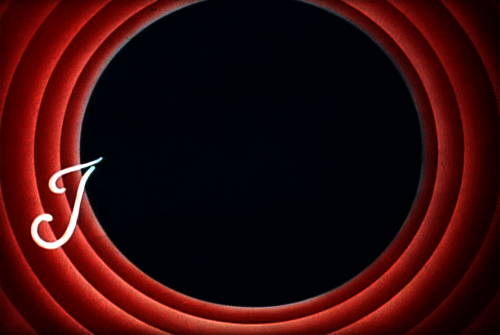
Great article on the M48 in Vietnam. But your caption on the photo of Tank C66 from 1/77 Armor is a M48A2, not a M48A3. It has the A2 headlights, heater exhaust pipe coming out to the left side of the drivers hatch, and no A3 air filter boxes on the fenders.
Please keep the articles coming!!!
LikeLike
Curious about the 4/69th from Ft. Benning and where and when they were deployed.
LikeLike
Wikipedia: 69th Armored Regiment
The 4th Battalion (4/69th) was activated in 1972 at 1st Brigade HHC 8th Infantry Division at the Robert E. Lee Barracks in Mainz Gonsenheim Germany.
Commanding Officers:
– LTC Dale Brudvig, 1972–??
– LTC Stewart W. Wallace June 1985 – June 1987
– LTC J. Steven Hunter June 1987 – October 1987
LikeLike
I second the comment above from Carlos: that color frontal view of an M-48 crossing the river is definitely of an M-48A2C. The registration number is 9B1258 clearly visible: the 9B serial numbers were only on M-48A2s and later on M-60 series viehicles. M-48A3s had 9A serial numbers since they were all rebuilt earlier model M-48s and particularly M-48A1s. Indeed, this exact same tank reappears later in your blog in the black and white photo of the vehicle taken during Operation Fisher in January 1969. My father trained as a tanker in M-48A2Cs at Fort Knox in 1966 and ‘67 before he went to Vietnam as a staff officer in the 4th ID based at Pleiku between ca. June 1968 and July or August of 1969. He apparently did not think too highly of the M-551 Sheridan, I believe the terminology used was “piece of junk”.
LikeLike
I have a buddy who is an expert on M48/M60 vehicles. He says too that the vehicle mentioned is an M48A2C. I have always thought it was an A3 until he corrected me.
The picture of ‘Hell Cat’ has me curious. The bumper number appears to be 4th ID, 4th Engineers.
LikeLike
The easy identifiable difference on the front of the M48A2C vs the M48A3 is the headlight guards.
LikeLike
Great article on M48s in Vietnam. You gave time to M88s but nothing to M578s. There were more M578s in the field than M88s for a couple reasons. First, the M88 weight was 70 tons and a lot of small bridges could not take this weight and also the M88 was gas powered as opposed to diesel. An RPG will ignite gas and 400 gallons of gas makes a big bang and will burn for days. As a crew chief on a few M578s, we also did field mods. Had dual 50s on the one I had with the 11th ACR. When I was with the 12 Cav, we had a 578 that we took to fire bases around Khe Sanh. We use to say, “Have 578 Will Travel”. Also ran convoy patrols, as no one wanted to leave a duce and a half full of ammo along the side of the road after a mine blew off the front tire.
LikeLike
My article is on M48s and vehicles based on the M48/M60 Patton chassis used in Vietnam. The M578 Light Recovery Vehicle is out of scope because it is based on the same light chassis of the M107 (175mm) and M110 (8 inch) SPs. Thanks for the additional info about the M578.
LikeLike
Hi All. I am helping 2-69 AR with a display at their HQ building – depicting MOH Dwight H Johnson’s fight January 1968. He was with 1-69 AR, 4th ID. Would that likely be a late production M48A3? Would they likely have a mod in front of the loader for an MG?
LikeLike
Some more interesting information:
MOH Dwight Hal Johnson Information
Dwight H. Johnson wikipedia
LikeLike
Thanks. I was able to review that. The citation does not give much information about detail. For instance, what happened to the rest of the crew? Did they bail out? Stay with the tank? Maybe they took cover behind the tank? I assume he did not throw track on the road, so was it in a ditch, or something else? I’m surprised there is not more information. In reviewing 1-69 photos I do see, it seems they did a field mod of an MG for the loader. That is interesting. I’m leaning towards depicting that for this January 1968 fight.
LikeLike
Served with 1st engineers 1st infantry div 1968 1969. We had four dozer tanks and did a lot of road security and then worked with the Rome plows. Did a lot of land clearing in the iron triangle.all the tanks were destroyed by mines or rpgs and were replaced with new tanks with no plows.
LikeLike
Helo.
Great article. Thank you.
I have a question.
One photo with the warning in vietnamese are two red arrows markings something on the front. What is the reason for the arrows?
Best regards
LikeLike
Peter –
I found that photo on the internet in an old forum. Someone had drawn (electronically) the red arrows on the photo to point something out on the front of the hull.
LikeLike
The FOUR tanks that the grunts ran into as they approached Hue City at the start of Tet ’68 were (2) M-48A3 gun tanks and (2) M-67A2 flame tanks from H&S Company, 3rd Tank Battalion. I was there…!!!
LikeLike
You can find more information about the 2/34th Armor in Vietnam at this old site…
2/34th Armor Battalion Laager Site
I served with B company from March 68 to March 69.
LikeLike
Did the ROK troops in Vietnam use M-48s – or any other tank?
LikeLike
Michael –
The South Koreans sent these infantry units to Vietnam:
– Capital Mechanized Infantry Division (Fierce Tiger)
– 9th Infantry Division (White Horse)
– 2nd Marine Brigade (Blue Dragon)
The Capital and 9th Infantry Divisions were equipped with M113 APCs .
Tank support was provided by US armor units.
LikeLike
Thanks for the info! I never heard of the ROKs having tanks but the TOE shows “Tank Companies”. The ROK using M-113s SUPPORTED by US armor makes sense tome
LikeLike
Great photos, stories, and comments here. Good work. Check out my article on “The Patton Tank in Vietnam” that was published in Armor magazine a few years ago. You can google the title on internet. Those tankers and M-113 guys were very brave crazy dudes. Enjoyed your web site. Thanks. —–Mike Kelley Massachusetts A shout out to my old DAV NSO friend, Stanly Hoy Jr. of the 1st Marine Tank Battalion, RVN.
LikeLike